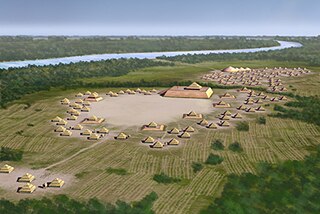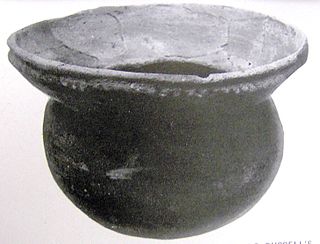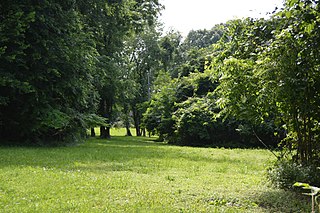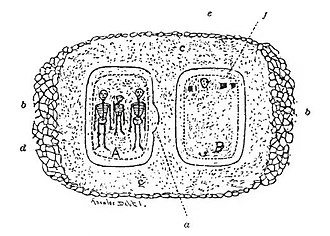
The Hopewell tradition, also called the Hopewell culture and Hopewellian exchange, describes a network of precontact Native American cultures that flourished in settlements along rivers in the northeastern and midwestern Eastern Woodlands from 100 BCE to 500 CE, in the Middle Woodland period. The Hopewell tradition was not a single culture or society but a widely dispersed set of populations connected by a common network of trade routes.

Since the publication of the Book of Mormon in 1830, Mormon and non-Mormon archaeologists have used archaeological evidence to contextualize the narratives. While members of the Church of Jesus Christ of Latter-day Saints and other denominations of the Latter Day Saint movement believe it describes ancient historical events in the Americas, the available historical and archaeological facts point to the book being an anachronistic invention of Joseph Smith.

Rakhigarhi or Rakhi Garhi is a village and an archaeological site belonging to the Indus Valley civilisation in the Hisar District of the northern Indian state of Haryana, situated about 150 km northwest of Delhi. It was part of the mature phase of the Indus Valley Civilisation, dating to 2600-1900 BCE. It was among the largest settlements of the ancient civilisation, though most of it remains unexcavated. The site is located in the Ghaggar River plain, some 27 km from the seasonal Ghaggar river. Initial excavations at the site happened in the 1960s, followed by further excavations in the late 1990s, however more sustained excavations have taken place in the past decade.

Lake Jackson Mounds Archaeological State Park (8LE1) is one of the most important archaeological sites in Florida, the capital of chiefdom and ceremonial center of the Fort Walton Culture inhabited from 1050–1500. The complex originally included seven earthwork mounds, a public plaza and numerous individual village residences.

The Criel Mound, also known as the South Charleston Mound, is a Native American burial mound located in South Charleston, West Virginia. It is one of the few surviving mounds of the Kanawha Valley Mounds that were probably built in the Woodland period after 500 B.C. The mound was built by the Adena culture, probably around 250–150 BC, and lay equidistant between two “sacred circles”, earthwork enclosures each 556 feet (169 m) in diameter. It was originally 33 feet (10 m) high and 173 feet (53 m) in diameter at the base, making it the second-largest such burial mound in the state of West Virginia. This archaeological site is listed on the National Register of Historic Places.

The Grave Creek Stone is a small sandstone disk inscribed on one side with some twenty-five characters, purportedly discovered in 1838 at Grave Creek Mound in Moundsville, West Virginia. If genuine, it could provide evidence of Pre-Columbian writing, but the discovery that the characters can be found in a 1752 book suggests that it is probably a fraud. While replicas have been made, the original stone has been lost. The only known image of the actual stone is a photograph of items in the E.H. Davis collection before the majority of the collection was sold to the Blackmore Museum.

A platform mound is any earthwork or mound intended to support a structure or activity. It typically refers to a flat-topped mound, whose sides may be pyramidal.

Spiro Mounds is an Indigenous archaeological site located in present-day eastern Oklahoma. The site was built by people from the Arkansas Valley Caddoan culture. that remains from an American Indian culture that was part of the major northern Caddoan Mississippian culture. The 80-acre site is located within a floodplain on the southern side of the Arkansas River. The modern town of Spiro developed approximately seven miles to the south.

The Toolesboro Mound Group, a National Historic Landmark, is a group of Havana Hopewell culture earthworks on the north bank of the Iowa River near its discharge into the Mississippi. The mounds are owned and displayed to the public by the State Historical Society of Iowa. The mound group is located east of Wapello, Iowa, near the unincorporated community of Toolesboro.

The Naples Mound 8 is a Havana Hopewell culture mound site located in Pike County, Illinois three miles east of the city of Griggsville. It is the largest mound on the bluff-top in the lower Illinois Valley. The mound was given the name Naples Mound #8 in 1882. The mound was listed on the National Register of Historic Places in 1975.
The Bat Creek inscription is an inscribed stone tablet found by John W. Emmert on February 14, 1889. Emmert claimed to have found the tablet in Tipton Mound 3 during an excavation of Hopewell mounds in Loudon County, Tennessee. This excavation was part of a larger series of excavations that aimed to clarify the controversy regarding who is responsible for building the various mounds found in the Eastern United States.

There are a number of words and phrases in the Book of Mormon that are anachronistic—their existence in the text of the Book of Mormon is at odds with known linguistic patterns or archaeological findings.

The Upper Mississippian cultures were located in the Upper Mississippi basin and Great Lakes region of the American Midwest. They were in existence from approximately A.D. 1000 until the Protohistoric and early Historic periods.

Bussell Island, formerly Lenoir Island, is an island located at the mouth of the Little Tennessee River, at its confluence with the Tennessee River in Loudon County, near the U.S. city of Lenoir City, Tennessee. The island was inhabited by various Native American cultures for thousands of years before the arrival of early European explorers. The Tellico Dam and a recreational area occupy part of the island. Part of the island was added in 1978 to the National Register of Historic Places for its archaeological potential.

Elden Pueblo was a prehistoric Native American village at the foot of Mount Elden near Flagstaff, Arizona. The pueblo is considered part of a major trading system. Various trade items, such as macaw skeletons from Mexico and shell jewelry from the coast of California, have been found throughout the site. The area is now protected and is used for research and educational purposes.

The Castalian Springs Mound State Historic Site (40SU14) is a Mississippian culture archaeological site located near the small unincorporated community of Castalian Springs in Sumner County, Tennessee. The site was first excavated in the 1890s and again as recently as the 2005 to 2011 archaeological field school led by Dr. Kevin E. Smith. A number of important finds have been associated with the site, most particularly several examples of Mississippian stone statuary and the Castalian Springs shell gorget held by the National Museum of the American Indian. The site is owned by the State of Tennessee and is a State Historic Site managed by the Bledsoe's Lick Association for the Tennessee Historical Commission. The site is not currently open to the public.

Potomac Creek, or 44ST2, is a late Native American village located on the Potomac River in Stafford County, Virginia. It is from the Woodland Period and dates from 1300 to 1550. There is another Potomac Creek site, 44ST1 or Indian Point, which was occupied by the Patawomeck during the historic period and is where Captain John Smith visited. This site no longer exists, as it eroded away into the river. Site 44ST2 has five ossuaries, one individual burial, and one multiple burial. Other names for the site are Potowemeke and Patawomeke. The defining features include distinctive ceramics, ossuary burials, and palisade villages.

The Etowah plates, including the Rogan Plates, are a collection of Mississippian copper plates discovered in Mound C at the Etowah Indian Mounds near Cartersville, Georgia. Many of the plates display iconography that archaeologists have classified as part of the Southeastern Ceremonial Complex (S.E.C.C.), specifically "Birdman" imagery associated with warriors and the priestly elite. The plates are a combination of foreign imports and local items manufactured in emulation of the imported style. The designs of the Rogan plates are in the Classic Braden style from the American Bottom area. It is generally thought that some of the plates were manufactured at Cahokia before ending up at sites in the Southeast.

The River Styx archaeological site is the site of a village and burial mound in North Central Florida that was occupied during the development of the Cades Pond culture out of the Deptford culture early in the Current Era (CE).
The Fisher Mound Group is a group of burial mounds with an associated village site located on the DesPlaines River near its convergence with the Kankakee River where they combine to form the Illinois River, in Will County, Illinois, about 60 miles southwest of Chicago. It is a multi-component stratified site representing several Prehistoric Upper Mississippian occupations as well as minor Late Woodland and Early Historic components.


















